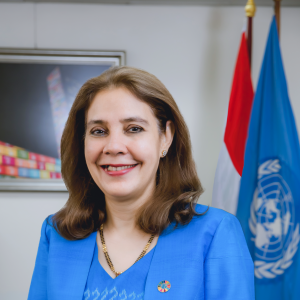Good morning. I am glad to see you all.
Let me warmly welcome you and our speakers who will give us important perspectives from island nations, cities and regional centres in line with the UN’s normative framework for advancing the SDGs, including sustainable cities.
Our four distinguished panelists today are Ms. Celeste Connors, CEO of Hawaii Local 2030 Hub; Hon. Ms. Noraini Roslan, Mayor of Klang, Malaysia; Mr. Jairaj Phatak, Director General All India Institute of Local Self-Government; and Mr. Riccardo Maroso, Programme Manager of UN Habitat.
I am very much looking forward to your invaluable insights during an exciting session. Following that, we will have a Q&A session so we can further pinpoint challenges at city level for solutions towards accelerating the 2030 agenda.
Let me take this opportunity to set out four key messages on SDGs and their localization nationwide in my role as the UN Resident Coordinator in Indonesia.
First, political commitment and policy leadership are key for front-lining SDGs into development planning and tracking progress.
Indonesia is a good example of this as the country has institutionalised the SDGs as part of its national and regional polices. It has also adopted a proactive approach by prioritising indicators as outlined in the SDG roadmap.
Priority indicators are mainstreamed into the government 5-year plan, making it mandatory for local governments to plan and allocate resources accordingly.
These policy efforts translate into 62% of the SDG indicators being on track nationally with the 17 goals moving in the right direction.
This indicates that Indonesia is on course to speeding up progress on the 17 SDGs over the next five years.
Second, SDG localization empowers local governments by facilitating a differentiated approach to set priorities with the greatest benefits to local economies, ecosystems, and communities.
It also allows them to track progress on these goals.
Indonesia and its cities champion VNRs and VLRs premised on qualitative methodologies. These provide a granular bottom-up perspective on their progress on the SDGs.
You will hear tomorrow directly from the Governor of Jakarta, the Governor of West Java and the Regent of Kendal on how this has enabled them to reorient their trajectories to address development challenges.
As the UN, we are leveraging these findings to inform our Cooperation Framework with Indonesia.
For example, the VLR in West Java highlights the need to reduce maternal mortality, undernourishment and the number of young people not in education while boosting employment and skills training.
This aligns with our strategy to support Indonesia in advancing its human capital development.
Third, bridging the SDG financing gap will demand leveraging innovative financing instruments in partnership with local governments and the private sector.
This is key to acceleration.
The financing gap for SDGs in Indonesia stands at $1.7trillion, which is slightly higher than the annual GDP.
Closing this gap will require strategic partnerships between government, financial markets, IFIs and the UN.
The UN in Indonesia has unlocked more than $10 billion through green sukuk as well as blue and SDG bonds issued by government and corporations. This financing is benefiting 48 million people with two in three of them being women, children and young people. They benefit through SDG-related government programs, which include vaccinations, scholarships, and basic services.
These instruments can be tailored to support local governments in generating additional financing for the SDGs through municipal bonds.
So far, the Government and the UN have assessed the financial viability of municipal bonds for 8 prospective provinces. If this goes forward, it could generate $2 billion additional financing for the SDGs.
Fourth, to fast-track the transformation into clean and green cities, partnerships with industry will be imperative to reduce emissions.
Indonesia has several examples of this to showcase.
In Aceh, South Sumatra, East and West Java provinces, the UN, in partnership with local governments and industry, is introducing enhanced oil recovery technology in fertiliser factories. This reduces emissions by 15% and cuts production costs by $47 million each year.
Similar ambition is being expanded to the iron and steel sectors by introducing electric arc furnaces, which reduces energy consumption.
This transformation needs to extend across cities to yield truly transformative outcomes.
Now let me give the floor to out distinguished speakers.
Thank you.



